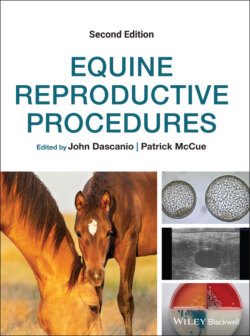Читать книгу Equine Reproductive Procedures - Группа авторов - Страница 59
Primary fibroblast cultures
ОглавлениеPlace a tissue biopsy, with a small amount of collection medium, into a sterile Petri dish and mince with sterile forceps and scissors to the size of 2–4 mm2. Wash the pieces 10 times in sterile collection medium (use a succession of Petri dishes).
Transfer the pieces of tissue into T25 flasks, approximately 4–6 pieces per flask. Add 0.5 ml culture medium and incubate at 37°C with 5% CO2 overnight. The pieces should get attached on the next day.
Check the pieces under an inverted microscope every day for the outgrowth of fibroblast cells, as well as for possible contamination. In the latter case, the cultures should be discarded.
Wash the pieces with HBSS/2× antibiotics–antimycotics and change medium (0.5 ml) every day. Do not let the pieces dry out. The first cells typically appear in a week.
When outgrowth is sufficient (~100 fibroblast cells around most of the pieces), remove the tissue pieces, aspirate the culture medium and wash the flasks twice with 5 ml of HBSS. Add 1 ml 0.25% trypsin‐EDTA and incubate for 5–10 minutes at 37°C to detach the cells. Without removing trypsin, add 2 ml culture medium, transfer the cells into a new T25 flask, add 5 ml fresh medium, and incubate at 37°C in 5% CO2. Check the cultures every day and change media every 2–3 days.
The cells can be grown in T25 flasks or, if more cells are needed, in T75 flasks. The transfer of cells from T25 to T75 is done with 0.25% trypsin‐EDTA as described in the previous step.
Cultures are ready for harvest when they are semiconfluent (~60–70%) and contain many mitotic cells visible as round, enlarged, partially detached bodies. Non‐diving fibroblasts appear as elongated bodies attached to the surface (Figure 22.1).
Note: Even though procurement and handling of biopsies and setting up primary fibroblast cultures is more laborious and time consuming compared with lymphocyte cultures, the advantage is that live fibroblasts can be cryopreserved in liquid nitrogen and used years later for additional cytogenetic studies and various advanced molecular analyses.
